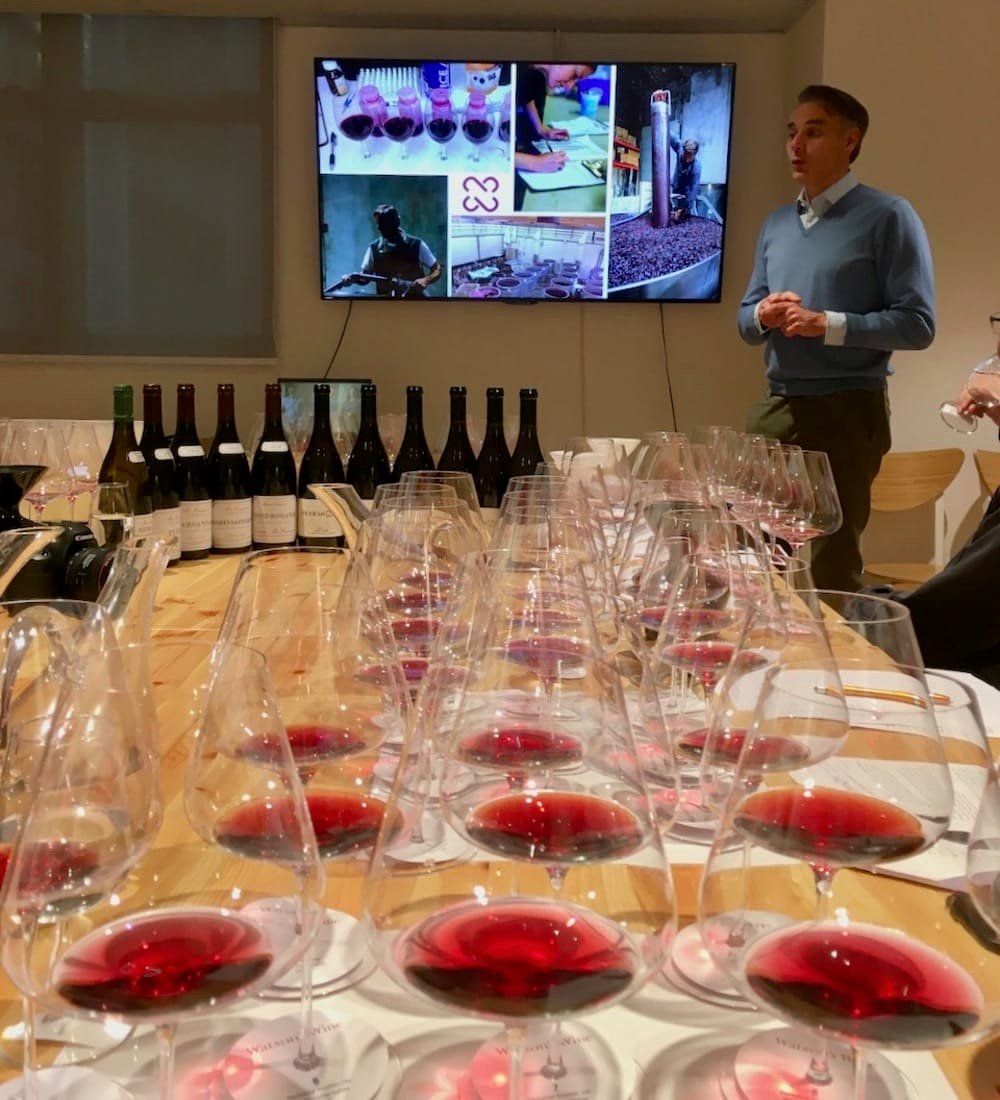Burgundy and Oregon maybe a world apart, but thanks to Jean-Nicolas Méo, the owner of Méo-Camuzet in Burgundy and partner of Nicolas-Jay in Oregon, we were able to compare Pinot Noirs from both sides of the Atlantic Ocean during the winemaker’s recent visit to town.
Family-owned Méo-Camuzet is located in Vosne-Romanée, Burgundy. In 1989, Méo joined his father after studying winemaking in Burgundy and then a stint in the USA . With his father, Jean, and well-respected Henri Jayer as his mentors, Méo experimented with different winemaking techniques and eventually developed his own style.
Méo prefers destemming as opposed to whole-bunch fermentation, although he may include around 10% of stems during fermentation. The grapes are cold-soaked at around 15ºC for a few days prior to fermentation in cement or stainless-steel tanks at up to 30ºC, then warm-soaked for a few days before pressing for further extraction. Depending on the fruit structure, each wine is aged with a different wood regime. Today, the domaine produces 25 wines, including Grands Crus and Premiers Crus from the region.

We tasted four Pinots, all 2016 vintages from different villages in Côte de Nuits. True to Burgundy’s distinctive terroir, the wines show different characteristics. I like the delicate aromas and velvety structure of Fixin, a lesser-known, small appellation with only 80 hectares under vines. In comparison, its neighbour Marsannay, a larger and more well-known appellation, produces wine with bright red fruits. Vosne-Romanée, with multilayered aromas and freshness, is my favourite. The two plots of vineyard, next to the family house, are located at a higher altitude. In contrast, the wine from Morey-Saint-Denis is sturdy, with a darker fruit profile and firm tannin. This is why Burgundy is unique – every appellation, no matter how close they are, has its own interpretation of Pinot Noir.

Méo met music producer Jay Boberg 30 years ago when he was in the USA. Sharing the same philosophies about life, wine and music – and especially their passion for Pinot Noir from Oregon – the pair eventually founded Nicolas-Jay in 2013. Méo was excited to take what he had learned from Burgundy to a new region with a different climate and soil.

Unlike Burgundy, Oregon has a wet spring but a dry summer. There are also differences in the soil, clones and working attitude. Burgundian is more intuitive, whereas Oregonian is more technical. Méo was humble enough to admit that he also has to learn from his US colleagues.
At the moment, Nicolas-Jay only produces Pinot Noir. They source grapes from three vineyards sites in Willamette Valley in Oregon and make three single-vineyard wines and two blends using grapes from across the valley.
Compared to Burgundy, Oregon wine is riper and more fruit forward, but there are still variations in different sites. The 2017 wine from the organic, dry-farmed Nyssa vineyard is generous with softer tannin, while the same vintage wine from the cooler, biodynamically-farmed Momtazi vineyard is more focused, uplifting and structured. The 2017 Own-Rooted Pinot Noir was made from vines at least 30 years old and planted on their own roots. The wine has more savoury notes, and it will be interesting to see how it develops. Méo also showed us three vintages of Willamette Valley Pinot Noir (2015–2017) to compare the different vintage conditions and their evolution.

The only white wine we tried was Hautes-Côtes de Nuits Clos Saint-Philibert 2016 from Méo-Camuzet, a very pleasant wine that Méo described as a cross between Chablis and Meursault. It possesses the freshness and mineral character of Chablis and, at the same time, the ripe stone fruit aromas and richness of Meursault. Côte de Nuits is a red wine region, but this particular vineyard is at an altitude of 1,200 feet with stony soil. Méo explained that Pinot Noir grown there lacks richness and volume, but the terroir is just perfect for a remarkable Chardonnay.

Running two wine estates thousands of kilometres apart and with harvests nearly at the same time is not easy. Méo said he is lucky that he can rely on resident winemaker Tracy Kendall. He travels to Oregon around four times a year, definitely at harvest time. Burgundy’s harvest is compact and briefer, so he is able to catch the end of Oregon’s harvest, which spreads over a longer period of time.
Both Méo-Camuzet and Nicolas-Jay wines are available in Hong Kong at Watson’s Wine.
For more wine articles like this, like Foodie on Facebook

